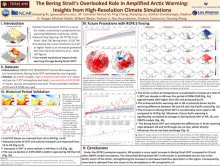The Bering Strait's Overlooked Role in Amplified Arctic Warming: Insights from High-Resolution Climate Simulations
Gaopeng
Xu
Texas A&M University
Poster
The Arctic region has experienced an alarming warming trend, nearly four times faster than the global average since 1979, with far-reaching global implications. However, future Arctic warming rates projected by models are uncertain. One of the key factors contributing to this uncertainty is the ocean heat transport (OHT) into the Arctic Ocean. While the impact of Atlantic OHT on Arctic sea ice and warming has been extensively studied, here we present compelling evidence that the OHT through the Bering Strait exerts a more substantial influence on Arctic warming than previously recognized. Our findings are derived from an unprecedented ensemble of high-resolution historical and future climate simulations (HR), which exhibit a 20% larger warming rate in the period of 2006-2100 compared to standard low-resolution model simulations (LR) commonly employed in the Intergovernmental Panel for Climate Change (IPCC) Assessment Reports. The enhanced warming in HR is primarily attributed to an increase of OHT through the narrow and shallow Bering Strait that is nearly four times larger than in LR. Consequently, our study suggests that the projected rate of Arctic warming by current IPCC-class models is likely to be underestimated due to insufficient model resolution in capturing future changes in Bering Strait OHT.

xu-gaopeng-polar-poster.pdf
(2.28 MB)
